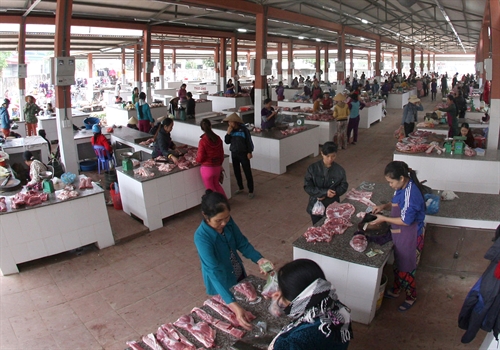 Economy
Economy

The landing of imported goods in the local traditional markets is inevitable as the Made-in-Vietnam products, favoured by Vietnamese due to their age-old habits, are being ignored by local retailers.
 |
| A traditional market in Đông Sơn District, Thanh Hóa Province. Việt Nam has more than 9,000 traditional markets and distributes some 80 per cent of goods to local consumers, but local retailers are ignoring this market. - VNA/VNS Photo Đình Huệ |
HÀ NỘI — Despite positive results of the “Vietnamese give priority to use Vietnamese goods” campaign, the ratio of Vietnamese goods being sold in traditional markets remains quite modest.
Lê Ngọc Sơn, head of Đồng Xuân Market Management Division of Đồng Xuân Joint-Stock Company, said Vietnamese goods were being displayed in the market, mostly made by small-sized local companies or traditional handicraft villages. Big producers prefer to stay away from this traditional market channel.
A retailer in Đồng Xuân market said local retailers often purchase a small volume of new products depending on the demand from local consumers first. Due to their limited capital, they always pay owners in full at the end of the year. Meanwhile, Vietnamese businesses often require them to place big orders and pay in advance thus causing much difficulty for them. In addition, local retailers are ignorant about Vietnamese products due to their inflexible payment methods, undiversified samples and high prices.
Phạm Thị Thanh Hà, deputy director of Đức Giang Fashion Centre, said her company has never distributed garments to traditional markets because her company wants to retain its image. She, however, said that if local retailers can prove their eligibility, her company is willing to deliver garments to them.
Most of Vietnamese products sold at traditional markets have low-added value.
According to the Ministry of Industry and Trade, Việt Nam has more than 9,000 traditional markets and distributes some 80 per cent of goods to local consumers. If Vietnamese goods can enter this channel it would become a very useful distribution channel.
For this, a consensus should be reached between retailers and businesses that will be a key to developing this channel. Market management divisions also play an important role in linking retailers and businesses.
Sơn said his company will soon conduct meetings between retailers and businesses to sell goods in this market.
According to Vũ Vĩnh Phú, chairman of the Hà Nội Supermarkets Association, local retailers must co-operate with each other and compete by improving the quality of products, prices and customer care services. And local businesses needed to pay more attention to local income earners via distribution channels at traditional markets, he said.
A representative of a manufacturing company said traditional markets have advantages as compared to supermarkets such as diversified and cheap products, and convenient locations. However, local businesses need to provide better product design and quality with reasonable pricing.
According to the ministry, to bring more Vietnamese goods into traditional markets, businesses should allocate their goods to local retailers at wholesale markets for distribution in rural areas. This would help businesses save costs while establishing their sales agents in rural areas. – VNS




